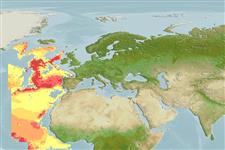>
Lophiiformes (Anglerfishes) >
Himantolophidae (Footballfishes)
Etymology: Himantolophus: Greek, himas or himantos = leather strap, thong or leash (referring to the thick leathery illicium) + Greek, lopho or lophio = crest or tuft (referring to the baited illicium projecting from the head) (Ref. 86949).
Environment: milieu / climate zone / depth range / distribution range
ນິເວດວິທະຍາ
ສັດທະເລ ກ່ຽວກັບ (ຢູ່) ຊັ້ນນ້ຳໃນທະເລເປີດທີ່ປອດແສງສ່ອງເຖິງ; ລະດັບຄວາມເລິກ 400 - 750 m (Ref. 86949). Deep-water
Eastern Atlantic: Iceland (Ref. 12462) and off Madeira (Ref. 12965).
ຂະໜາດ / ນ້ຳໜັກ / Age
Maturity: Lm ? range ? - ? cm
Max length : 21.5 cm SL (female)
ຄີຫຼັງຂອງປາ (ຄີອ່ອນ) (ທັງໝົດ) : 5; ຄີກົ້ນຂອງປາ: 4. Distinguishing characteristics of metamorphosed female: length of illicium 56-87% SL; bifurcated distal escal appendage some distance from base; each primary branch simple and darkly pigmented in small specimens, faintly pigmented in large specimens; length of primary branch 35-40% SL in specimens 3-3.8 cm, 78-83% in specimens 8.6-15.5 cm; unpigmented posterior escal appendage , length 3.5-13% SL; postolateral appendage on illicium 0-5, longest appendage 0-6.3%SL; escal bulb and appendages lacking dermal spinules (Ref. 86949).
Caught in bottom trawls and open pelagic nets in 400-750 m (Ref. 86949).
Life cycle and mating behavior
Maturities | ການສືບພັນ | Spawnings | Egg(s) | Fecundities | ຕົວອ່ອນ
Jonsson, G., 1992. Islenskir fiskar. Fiolvi, Reykjavik, 568 pp. (Ref. 12462)
IUCN Red List Status (Ref. 130435)
Threat to humans
Harmless
Human uses
ເຄື່ອງມື
Special reports
Download XML
ແຫຼ່ງອີນເຕີເນັດ
Estimates based on models
Phylogenetic diversity index (Ref.
82804): PD
50 = 0.5000 [Uniqueness, from 0.5 = low to 2.0 = high].
Bayesian length-weight: a=0.01995 (0.00906 - 0.04395), b=3.01 (2.83 - 3.19), in cm total length, based on all LWR estimates for this body shape (Ref.
93245).
ຊັ້ນເຂດຮ້ອນ (Ref.
69278): 4.4 ±0.7 se; based on size and trophs of closest relatives
Fishing Vulnerability (Ref.
59153): Low vulnerability (16 of 100).
